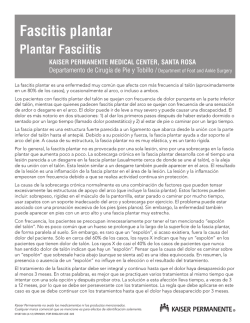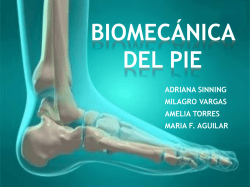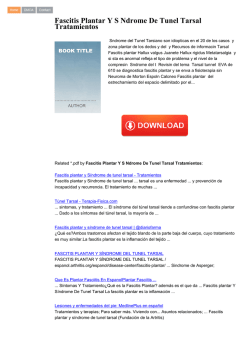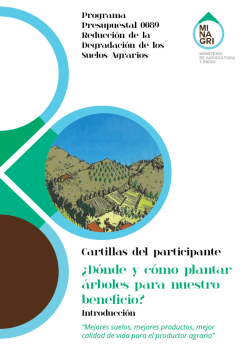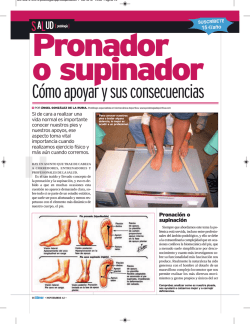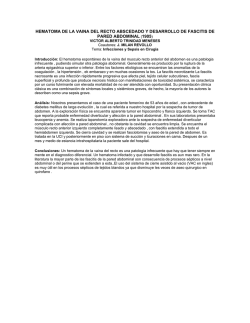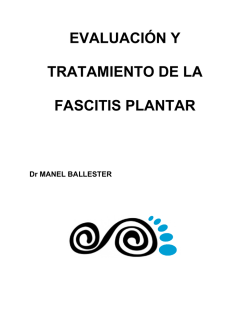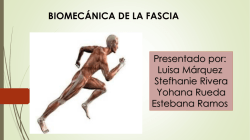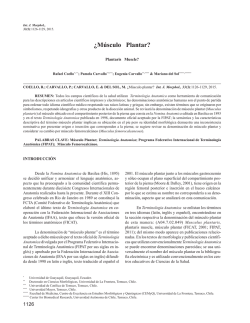
Tratamiento Multidisciplinar de las Lesiones
el doctor opina doctor’s opinion VIDA SANA HEALTHY LIVING Por/ by: patricia mattey Dr. Manuel Villanueva. Sports medicine successfully prevents many runners’ injuries and treats them non-invasively thanks to techniques developed by Spanish orthopaedic specialists. Una carrera segura R A safe race La medicina deportiva logra prevenir múltiples lesiones de los corredores y tratarlas de forma no invasiva gracias a técnicas desarrolladas por traumatólogos españoles. C orrer está de moda. Desde Madrid hasta Nueva York, en todas las ciudades se celebran carreras populares y maratones y cada vez más aficionados sueñan con calzarse las zapatillas. Hay muchas razones para correr: estar en forma, cuidar el corazón, los músculos, el peso o la salud mental. Pero se debe correr con cabeza. Es necesario pasar un chequeo médico que descarte enfermedades cardiacas, además de realizar un estudio biomecánico de la pisada y elegir el calzado deportivo adecuado para prevenir lesiones, como la fascitis plantar. La fascitis plantar representa el 10 por ciento de las lesiones de los corredores y es la principal causa de dolor en el talón. Afecta a adultos entre 25 y 65 años y a deportistas de élite, como Pau Gasol. La fascia plantar es una estructura de tejido colágeno que se expande, a modo de abanico, desde el calcáneo hasta la región anterior del pie. Amortigua los impactos y da soporte al pie en todos sus movimientos. Los traumatismos repetidos pueden llegar a ocasionar la degeneración del tejido colágeno pasando de un cuadro inflamatorio, en las fases agudas, a un cuadro degenerativo crónico. Lo importante es que ante el mínimo dolor en el talón que persista al levantarse de la cama, tras el reposo o en plena carrera, se debe parar y consultar con un especialista. La historia clínica y el examen físico, junto con las pruebas de imagen, determinarán si existe o no una fascitis plantar. 78 | ronda iberia unning is in fashion. From Madrid to New York, popular races and marathons are held in a great many cities, and more and more enthusiasts dream of slipping on a pair of running shoes. There are a lot of reasons to take up running: keeping in shape, looking after the heart and the muscles, weightwatching, and bolstering mental health. But runners have to use their heads. They should have a medical checkup to discard the possibility of heart disease, a biomechanical analysis of their gait, and the right sports shoes in order to prevent injuries like plantar fasciitis. Plantar fasciitis accounts for 10 per cent of runners’ injuries, and is the principal cause of pain in the heel. It affects adults between 25 and 65, including élite sportsmen like Pau Gasol. The plantar fascia is a collagen tissue structure that opens out like a fan from the calcaneus to the back part of the foot. It softens impacts and supports the foot in all its movements. Repeated traumas can lead to the degeneration of the collagen tissue, going from inflammation in the acute stage to full degeneration when chronic. At the slightest feeling of pain in the heel that persists after getting out of bed, after a rest or while running, the important thing is to stop exercising and consult a specialist. A physical examination, together with the patient’s clinical history and imaging tests, will determine whether or not plantar fasciitis is the cause. Multidisciplinary treatment A nte cualquier molestia de la planta del pie que dure más de una semana se debe consultar con un experto. El doctor Manuel Villanueva, codirector de Avanfi-tulesiondeportiva.com, puntualiza: “Lo ideal es ser atendido por un equipo multidisciplinar. El estudio biomecánico de la pisada, la confección de unas plantillas personalizadas, los estiramientos, la terapia física y el uso de ortesis son la fase inicial del tratamiento conservador”. Las terapias más avanzadas como la electrolisis percutánea intratisular, el plasma rico en factores de crecimiento, o las ondas de choque buscan la reparación y regeneración del colágeno de la fascia, generalmente con éxito. Sin embargo, un 10 por ciento de los casos se cronifica y requieren cirugía. “Las opciones clásicas (intervención abierta o por endoscopia) requieren incisiones de dos a seis cm, anestesia de la pierna e isquemia (cortar el riego sanguíneo)”. Frente a esto, la cirugía ecoguiada que se hace sin isquemia y con anestesia local, por lo que su uso en la medicina deportiva y en la traumatología van en aumento. Así lo ha entendido la American Academy of Orthopaedic Surgeons que ha premiado a tulesiondeportiva.com (M. Villanueva, Á Iborra, Á. de la Rubia, F. Benito y A. Ríos) por una técnica quirúrgica ecoguiada para la fascitis plantar. I Cirugía ecoguiada Eco-guided surgery Esta técnica quirúrgica se realiza con una incisión de 1-2 mm, de forma ambulatoria y permite el apoyo inmediato del pie tras la intervención. Ofrece una mayor precisión, seguridad y eficacia, con menor dolor y menor tiempo de recuperación y no está contraindicada en pacientes con diabetes o insuficiencia vascular. This is an ultra-minimally invasive surgical technique carried out with an incision of 1-2 mm. Performed on an out-patient basis, it allows the patient to rest on the foot immediately after the operation. It offers greater precision, safety and efficiency, with less pain and a shorter recovery time, and it is not contraindicated for patients with diabetes or venous insufficiency. Tratamiento multidisciplinar Las pruebas de imagen ayudan a detectar la fascitis plantar. Imaging tests help detect plantar fascia. f any discomfort in the sole of the foot lasts more than a week, an expert should be consulted. Dr Manuel Villanueva, co-director of Avanfitulesiondeportiva.com, specifies that “the ideal thing is to be treated by a multidisciplinary team. A biomechanical analysis of the gait, the fabrication of customised insoles, stretching, phyiscal therapy and the use of orthesis form the initial phase of conservative treatment.” More advanced therapies such as intratissue percutaneous electrolysis, platelet-rich plasma or shock waves seek to repair and regenerate the collagen of the fascia, generally successfully. However, 10 per cent of cases become chronic and require surgery. “The classic options (open intervention or endoscopy) require incisions of 2 to 6 cm, anaesthesia of the whole leg, and an ischaemia (cutting off the blood flow).” The alternative is eco-guided surgery, which is carried out without ischaemia and with a local anaesthetic, and so is increasingly indicated for sports medicine and orthopaedic surgery. One body that agrees is the American Academy of Orthopaedic Surgeons, which has presented tulesiondeportiva.com with an award for its eco-guided surgical technique for plantar fasciitis. ronda iberia | 79
© Copyright 2025
